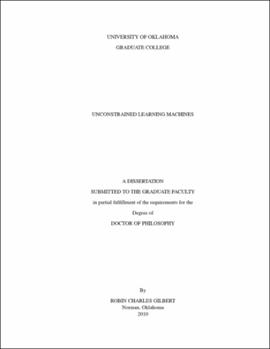| dc.contributor.advisor | Trafalis, Theodore B | |
| dc.creator | Gilbert, Robin Charles | |
| dc.date.accessioned | 2019-04-27T21:36:29Z | |
| dc.date.available | 2019-04-27T21:36:29Z | |
| dc.date.issued | 2010 | |
| dc.identifier | 99334733902042 | |
| dc.identifier.uri | https://hdl.handle.net/11244/319132 | |
| dc.description.abstract | With the use of information technology in industries, a new need has arisen in analyzing large scale data sets and automating data analysis that was once performed by human intuition and simple analog processing machines. The new generation of computer programs now has to outperform their predecessors in detecting complex and non-trivial patterns buried in data warehouses. Improved Machines Learning (ML) techniques such as Neural Networks (NNs) and Support Vector Machines (SVMs) have shown remarkable performances on supervised learning problems for the past couple of decades (e.g. anomaly detection, classification and identification, interpolation and extrapolation, etc.). | |
| dc.description.abstract | Nevertheless, many such techniques have ill-conditioned structures which lack adaptability for processing exotic data or very large amounts of data. Some techniques cannot even process data in an on-line fashion. Furthermore, as the processing power of computers increases, there is a pressing need for ML algorithms to perform supervised learning tasks in less time than previously required over even larger sets of data, which means that time and memory complexities of these algorithms must be improved. | |
| dc.description.abstract | The aims of this research is to construct an improved type of SVM-like algorithms for tasks such as nonlinear classification and interpolation that is more scalable, error-tolerant and accurate. Additionally, this family of algorithms must be able to compute solutions in a controlled timing, preferably small with respect to modern computational technologies. These new algorithms should also be versatile enough to have useful applications in engineering, meteorology or quality control. | |
| dc.description.abstract | This dissertation introduces a family of SVM-based algorithms named Unconstrained Learning Machines (ULMs) which attempt to solve the robustness, scalability and timing issues of traditional supervised learning algorithms. ULMs are not based on geometrical analogies (e.g. SVMs) or on the replication of biological models (e.g. NNs). Their construction is strictly based on statistical considerations taken from the recently developed statistical learning theory. Like SVMs, ULMS are using kernel methods extensively in order to process exotic and/or non-numerical objects stored in databases and search for hidden patterns in data with tailored measures of similarities. | |
| dc.description.abstract | ULMs are applied to a variety of problems in manufacturing engineering and in meteorology. The robust nonlinear nonparametric interpolation abilities of ULMs allow for the representation of sub-millimetric deformations on the surface of manufactured parts, the selection of conforming objects and the diagnostic and modeling of manufacturing processes. ULMs play a role in assimilating the system states of computational weather models, removing the intrinsic noise without any knowledge of the underlying mathematical models and helping the establishment of more accurate forecasts. | |
| dc.format.extent | 163 pages | |
| dc.format.medium | application.pdf | |
| dc.language | en_US | |
| dc.relation.requires | Adobe Acrobat Reader | |
| dc.subject | Machine learning | |
| dc.subject | Neural networks (Computer science) | |
| dc.subject | Support vector machines | |
| dc.title | Unconstrained Learning Machines | |
| dc.type | text | |
| dc.type | document | |
| dc.thesis.degree | Ph.D. | |
| ou.group | College of Engineering::School of Industrial Engineering | |
